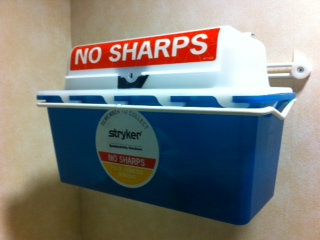How to Use a Pulse Oximeter
 Reusable pulse oximeter
Reusable pulse oximeterAt my hospital job as a certified nursing assistant (CNA), my reusable pulse oximeter, also known as a finger probe, was my best friend. I carried one around with me everywhere I went. They are useful in households as well, but are a dream come true in facilities like these.
It was tiny enough to fit in my pockets, but I chose to wrap it over my shoulders while I was checking my patients' vital signs. It made it that much more accessible. This is something I also do as a registered nurse (RN) with my stethoscope.
Just clip it on the end of the patient's finger and almost instantly, you get a pulse rate and oxygen saturation.
Disposable Alternative placement Troubleshooting Fingertip Pin
 Disposable pulse oximeter
Disposable pulse oximeterDisposable Pulse Oximeters
If you want to continuously monitor a patient's pulse rate, disposable ones are available as well. These are often used in conjunction with a heart monitor.
They have an adhesive side that make them easier to keep on, and at the same time, gives you more places to check the pulse. The downfall is that they are a little trickier to put on than the reusable ones.
There should be a dotted line in the middle of the adhesive part which indicates where the tip of the finger should be. Then the two ends should be pushed down the front and back of the finger. You should have some adhesive left on the sides that wrap around the finger and overlap each other so it is more secure.
 Pulse oximeter on finger
Pulse oximeter on fingerAlternative Placement
Other common places a pulse oximeter is used besides the finger are the toe, earlobe, and forehead. These places are especially useful when the patient doesn't understand that we want to continuously check their pulse rate. They will often take it off of their finger not realizing that is is important that they keep it on.
In cases like these, the next best place would be their toe. For the patient's benefit, you can even put socks on their feet to cover up the pulse ox entirely. This will not affect the reading.
The earlobe can be tricky especially if the patient has small ears but it is possible. Just fold it over the earlobe.
The least preferred option would be the forehead and should be used as a last resort because of its inaccuracy. In cases where everything else is too cold for the pulse ox to read properly, the forehead may be the only option.
 Pulse oximeter close up
Pulse oximeter close upTroubleshooting
If the pulse rate seems to be really high or really low, don't freak out just yet. Give the pulse oximeter about 30 seconds or so to get a constant reading. If it is still giving an off the wall reading, recheck that it is in proper working condition and that it is on properly.
Make sure it is not slipping off or losing its stickiness. This can be especially true with the disposable oximeters. They tend to get wet from sweat or water (from handwashing), or simply get pulled off by getting caught on something. In cases like these, it is usually best to just replace it.
 Pulse oximeter recycle bin
Pulse oximeter recycle binWorking in a hospital, we actually recycle them so if you are working in a similar facility, make sure they don't do the same thing before you throw them away.
One thing many people may not know is that fingernail polish will drive these things wild. If a patient has fingernail polish and doesn't want to remove it, you can usually get a pulse rate from putting the pulse ox sideways on the finger avoiding the fingernail altogether.
A common misconception is that fingers that are partially amputated can not be used for finger probes but this is false. I have used such fingers plenty of times and got a perfectly good pulse rate.
 Pulse oximeter cable
Pulse oximeter cableFingertip Pulse Oximeter
Fingertip pulse oximeters are the kinds you will often see outside of the hospital setting. Many nursing homes, doctor's offices, or even someone who wants to keep an eye on their oxygenation at home will typically use these. They are small enough to fit in the smallest pockets so they can really be used anywhere.
They are also fairly cheap with many options less than $20. Below are links to purchase one. Even if you are just curious as to how they work and how easy they are to use, get one and try it out. They're one of the more accessible medical devices that can be used by anyone.
Pin this content!
List of Caregiver Supplies and Equipment
From How to Use a Pulse Oximeter to Home
Recent Articles
-
Lifestyle Medicine Explained: Guiding You Back to Better Health
Apr 20, 25 09:51 AM
Did you know that 80% of chronic diseases—like heart disease, diabetes, and obesity—are preventable through lifestyle changes? Yet, many people rely solely on medication rather than addressing the roo… -
What to Expect During Post-Operative Recovery at Home - Caregiverology
Apr 08, 25 08:21 PM
Surgery may be over, but the journey to full recovery is just beginning, and for many people, the hardest part happens after they leave the hospital. -
How to Plan for Aging: Financial, Health, and Lifestyle Considerations
Mar 29, 25 12:40 PM
Did you know that 70% of people over 65 will need some form of long-term care? Yet, many delay planning until it’s too late. Aging is inevitable, but how we experience it depends on preparation.





New! Comments
Have something to say about what you just read? Leave a comment in the box below.